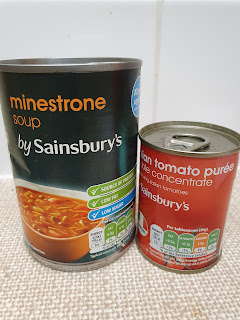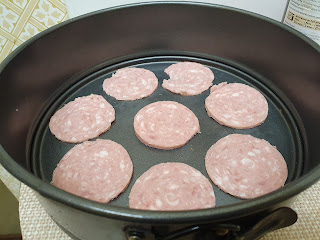One of the many books, pamphlets and recipe cards I have added to my collection over recent years is this slender but nonetheless excellent spiral-bound tome, "101 Things to Do With Canned Soup", by Donna Kelly and Stephanie Ashcraft.
I'm not sure it really needs much explanation as to what it is about - it does pretty much exactly what it says on the tin. Some might say that a whole chapter on Soups is cheating slightly - but in fact each of these recipes takes one or two tinned soups and makes something far more interesting out of them.
Coming from the USA, quite a lot of the recipes feature cans of condensed soup, which seem to be much more prevalent there than here. Condensed soup does lend itself very well to use in recipes ,for its ability to become a near-enough instant sauce, or the base of a casserole (which seems to be a more generic term for anything cooked in sauce in a dish in the oven, rather than a kind of stew as the term tends to refer to here) and many of the 101 uses are variations on this idea.
In the UK, you very rarely see condensed soups apart from Campbell's, and even then we only have four of their varieties avaiable: mushroom, chicken, celery, and of course tomato, Andy Warhol's favourite. In the States, you can walk into a store and be confronted by an almost overwhelming selection of Campbell's options - it really is quite extraordinary.
I will write more about Campbell's offerings from both sides of the pond another time; the use of the extensive US range does however mean that quite a few of the recipes in 101 Things are beyond my reach, if strictly adhering to the recipes. (though sometimes it is fun to improvise and do the best you can).
One recipe that had caught my eye, which uses a tinned soup readily available here, was the "Upside-Down Pizza Casserole". Sounds bizarre, but in effect it is a savoury take on a tarte tatin, or an Upside-Down cake. Combined with a pizza...
The tinned soup called for on this occasion was minestrone, which traditionally would have been a rustic, thrifty soup made by peasants in rural areas, now considered a classic of the Italian cucina povera ("poor kitchen"). I had not appreciated previously that the literal translation of minestrone is "big soup", since it was a big chunky soup bulked out with whatever was to hand, be that vegetables, beans or even pasta. I suppose the naming of Heinz's "Big Soup" range is a nod to this; I had always just thought it was called that because they were chunky soups in slightly bigger tins.
Going by the recipe, you then dump what remains of your soup into a casserole dish, stir in a small can of tomato paste, some garlic powder, Italian seasoning, and some diced pepperoni or Italian sausage, and then sprinkle grated mozzarella and parmesan on top of that. I went for a little more of a structured approach, laying slices of sausage on the bottom of the cake tin that I'd decided to use, so that when the pizza was inverted after cooking, they would sit proudly on the top. Then I spread over the minestrone/tomato paste mixture, to which I had added finely chopped fresh garlic (not having any powdered stuff) and a sprinkling from a tub of Italian Rub ("a blend of herbs and spices for Italian-inspired dishes") which I guessed would be close enough to the specified Italian seasoning. Then on went the cheese.
The recipe then calls for a tube of refrigerated pizza dough to be unrolled and laid on top of the cheese. This isn't a product that is readily available in the UK, so instead I opted for a part-baked pizza base (its shape being the reason I went for a round cake tin rather than a casserole dish), sitting it neatly on top, and hoping that it wouldn't affect the outcome of pizza too much.
The recipe called for a 40-50 minute bake at 350 degrees Fahrenheit, until the crust is browned. Being already part-baked, my pizza base wasn't going to need as long as that, so I reduced the cooking time a bit to avoid over-baking. The sauce appeared to be nicely bubbling at the edges when I took it out of the oven after about half an hour.
If you go by the recipe, you then cut it into squares, and turn upside down on each person's plate as you serve. I was keen for a bit more of the drama you get when turning out an Upside Down Cake or Tarte Tatin - that "hold your breath" moment when you invert the entire thing and then reveal whether it has been a success of not. So, I carefully put a plate over the top of the tin, and in one swift movement to flip it over without the plate sliding off, the pizza slopping out, or (my biggest fear) severely burning myself on the hot tin. I removed the tin, to reveal...
Hmm. Looked like a few of the pieces of sausage must have stuck to the bottom of the tin - but that was easily rectified.
Perhaps with a longer baking time (if I had used a completely raw pizza dough as the recipe stated), more of the liquid from the sauce would have bubbled away, or soaked into the dough, making it a bit less of a sloppy mess. I also wonder if it might have made more sense to put the sauce on top of the cheese, and then the pizza base, which is how the layers would go if making a pizza the right way up. Or would that have made the base too soggy? But this was never going to be an authentic Italian pizza, and for all its messiness, I quite enjoyed it - it was a little odd having pieces of pasta, peas, beans and the odd carrot in the sauce, but it was rich and tasty thanks to the tomato paste; there was melted cheese, sausage and a nicely crisp base. All in all, not much to object to. And making it upside-down and then flipping it over added a bit of spectacle to the proceedings - it might be a fun one to serve up for a family meal with the kids. Although they might turn their noses up at it, saying it doesn't look like "proper" pizza. Which, to be fair, is very true.
It was only afterwards that I realised I had missed an opportunity - the most well-known sort of Upside Down Cake is of course pineapple - which itself is sometimes added to pizza, depending on what your feeling about that is. So this could have been a Ham & Pineapple Upside Down Pizza Pie. Maybe another time.
While we're on the subject of minestrone, some time later I was flicking through the pages of the excellent Tin Can Cook by Jack Monroe (which I reviewed last year) and realised I had all the ingredients required for her "Tin-estrone" - that is, a minestrone made with various different tins. Drain a tin of spaghetti hoops and another of baked beans of their thick, overly sweet sauce, then add these to some softened onions and garlic, a tin of chopped tomatoes and another of vegetables (Jack suggests just carrots; I went for mixed veg which included carrots, potato, peas and green beans) and some stock, simmer for 10 minutes and you're done.



























No comments:
Post a Comment